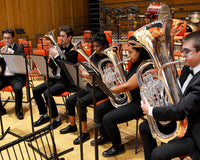What is a Trombone?
The Trombone is a member of the brass family of instruments. Trombones can be found in all genres of music - from orchestras/ wind bands and even to provide backing for modern pop music. The Trombone is loved for its vocal like qualities. The Trombone is different to all other brass instruments as it uses a slide to change notes instead of valves. To change notes the slide is moved in or out. This changes the length of the air column. As the tube lengthens, the air column also gets bigger which makes the pitch alter. The main types of Trombones are the standard Tenor in Bb, Tenor Bb/f or Bass Trombone. Also available is the Alto Trombone (which is pitched higher than a Bb Trombone) and is a good way to introduce younger children to playing. Here I will explain the differences to give anyone looking to purchase a trombone a good idea of which instrument is suitable for there needs.
What is the basic style of Trombone?  The basic trombone is the standard Bb Tenor Trombone. This straight trombone has been around since the early 17th century and its design hasn't really changed; apart from it growing in size. They are pitched in Bb and can be found in every style of music, ranging from orchestras to swing bands as well as popular music. These trombones are great for beginners lightweight and great value for money. Although it's not just for beginners as some people like the fact these are the most open sounding. This style of trombone also gives the best free blowing feel to the performer due to there only being 2 bends on the instrument. The only problem is that you need a decent arm length size to reach all the way to 7th position.
The basic trombone is the standard Bb Tenor Trombone. This straight trombone has been around since the early 17th century and its design hasn't really changed; apart from it growing in size. They are pitched in Bb and can be found in every style of music, ranging from orchestras to swing bands as well as popular music. These trombones are great for beginners lightweight and great value for money. Although it's not just for beginners as some people like the fact these are the most open sounding. This style of trombone also gives the best free blowing feel to the performer due to there only being 2 bends on the instrument. The only problem is that you need a decent arm length size to reach all the way to 7th position.
The Tenor Trombone with valve attachment  This Trombone is roughly the same size as the standard Bb Tenor Trombone as listed above but generally has a larger bore (slide width) and bell then the standard Bb Trombone. This allows a greater projection and therefore making a larger sound. Beware you will need more air to make it sound full. The main difference is the extra tubing around the bell section and a valve. This allows the Trombone to be transposed into lower keys to extend the trombone’s range, also aiding tuning and to create alternative slide position to aid faster playing. It is also useful for performers who can’t reach all the way to the end of the slide. The extra tubing means this instrument is a little heavier then the straight models. The main type of valves used is the rotary valve but more can be found. Each valve type has its own playing qualities; however, none will ever play as open as the straight Tenor Trombones.
This Trombone is roughly the same size as the standard Bb Tenor Trombone as listed above but generally has a larger bore (slide width) and bell then the standard Bb Trombone. This allows a greater projection and therefore making a larger sound. Beware you will need more air to make it sound full. The main difference is the extra tubing around the bell section and a valve. This allows the Trombone to be transposed into lower keys to extend the trombone’s range, also aiding tuning and to create alternative slide position to aid faster playing. It is also useful for performers who can’t reach all the way to the end of the slide. The extra tubing means this instrument is a little heavier then the straight models. The main type of valves used is the rotary valve but more can be found. Each valve type has its own playing qualities; however, none will ever play as open as the straight Tenor Trombones. 
The extra tubing will usually come in two different configurations open or closed wrap. The length of the tube will be the same but normally the open wrap trombones have a slightly more open feel when using the valve section due to fewer sharp bends and straighter tubing. The Valve section normally is in F, so if you play a note engaging the rotor in 1st position (slide all the way in), it will sound like you are playing an F in 6th position. Due to the extra manufacturing these trombones can be a bit more expensive then the straight tenor trombones.
The Bass Trombone
This is bigger then the tenor trombone with the valve attachment. It has the largest bell of the common trombone family ranging from 9.5 inch diameter up to 11. It also features the largest bore of the common trombones. Bass Trombones can vary in the number of valves attached to it. Some bass trombones still only have the 1 valve like the tenor trombone or now most commonly are found with 2. The instrument itself is larger to aid projection and how loud you can play especially when playing down low. There are a few reasons why people play a single valve bass trombone with the weight of two valves being the main one.  With two Valve attached the bass trombone is a lot heavier and more expensive than the single valve bass. There are many different configurations of the 2nd valve ranging in pitch from Eb down to Db these are all down to the performer’s preference. There are two types of 2nd valve:
With two Valve attached the bass trombone is a lot heavier and more expensive than the single valve bass. There are many different configurations of the 2nd valve ranging in pitch from Eb down to Db these are all down to the performer’s preference. There are two types of 2nd valve:
- Dependant requires the 1st valve to be engaged to work. This is useful just for the notes that cannot be played in tune with one trigger like low B.
- Independent valve system is the most popular option with professionals due to offering the performer an extra set of slide positions to aid tuning and make easy slide changes.
What is an alto Trombone?
An Alto Trombone is the smallest common trombone, these first started out in the 16th through to the 18th Century as the highest voice in the trombone section. Pitched in Eb (fourth higher) than the standard tenor trombone, this instrument has made a revival recently especially in the education sector. This instrument type is becoming more popular due to it being shorter and lighter than the normal tenor trombone as it allows younger children to take up the Trombone.
Summary
I hope this article has helped to understand the different types of Trombones and some of their key factors that make each one suitable for different uses. One thing I would recommend as a professional trombonist is ‘see what instruments people are using in your playing style, a popular choice is a safe choice to start off with.’















